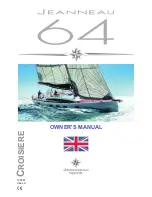
Carbon Monoxide Hazard During Operation
Carbon monoxide (CO) in the engine exhaust is a poisonous gas
which is odorless, colorless, and heavier than air. Direct prolonged
exposure can result in carbon monoxide poisoning which can be
harmful and may be fatal.
Indications of excessive exposure to carbon monoxide concentra-
tions may include nausea, dizziness and drowsiness. Carbon
monoxide poisoning requires the operator’s special and immediate
attention! To prevent excess exposure and reduce the possibility of
carbon monoxide accumulation in the cabin of the boat, ensure ade-
quate ventilation by opening cabin hatches, cabin doors, cabin
windows, and side windshield vents to increase air movement.
Some Chaparral models are equipped with a CO detector. Follow the
operating instructions supplied with the CO detector and test the unit
to verify that it is functioning properly every time you use your boat.
Refer to the information provided by the manufacturer in your owner’s
packet to determine replacement interval for your CO detector.
The following illustrations show how carbon monoxide can possibly
accumulate in your boat while at the dock or underway. Become
familiar with these examples and their precautions to prevent dan-
gerous accidents from occurring on your boat.
2-9
DANGER:
Blocked hull exhaust outlets near a pier, dock, sea
wall bulkhead or any other means can cause excessive accumu-
lation of poisonous carbon monoxide gas within the cabin areas.
Make sure hull exhaust outlets are not blocked. (Figure 2.1)
Figure 2.1 Running engine or generator in confined areas
DANGER
Carbon monoxide (CO)
can cause brain damage
or death.
Engine and generator exhaust contains odorless
and colorless carbon monoxide gas.
Carbon monoxide will be around the back of the
boat when engines or generators are running.
Move to fresh air, if you feel nausea, headache,
dizziness, or drowsiness
NW-206-06
WARNING
Carbon monoxide (CO)
can cause brain damage or death.
Engine and generator exhaust contains odorless and colorless carbon monoxide gas.
Signs of carbon monoxide poisoning include nausea, headache, dizziness, drowsiness,
and lack of consciousness.
Get fresh air if anyone shows signs of carbon monoxide poisoning.
See Owner’s Manual for information regarding carbon monoxide poisoning.
NW-204-06
WARNING
Carbon monoxide (CO)
can cause brain damage or death.
Carbon monoxide can be present in the cabin.
Signs of carbon monoxide poisoning include nausea, headache,
dizziness, drowsiness, and lack of consciousness.
Get fresh air if anyone shows signs of carbon monoxide poisoning.
Get fresh air if carbon monoxide detector alarm sounds.
Carbon monoxide detector must be functioning at all times.
NW-205-05
CLOSE WINDOW
LEAVING WINDOW OPEN WHILE BOAT
IS UNDERWAY OR AT DOCK
COULD INDUCE EXHAUST FUMES INTO
CABIN CAUSING INJURY OR DEATH.
WA R N I N G
Summary of Contents for SSI 180
Page 2: ......
Page 4: ......
Page 12: ...vi...
Page 19: ...1 7...
Page 20: ......
Page 24: ......
Page 26: ......
Page 42: ...2 16...
Page 62: ...3 20...
Page 92: ...5 16...
Page 110: ......
Page 118: ......
Page 124: ......
Page 125: ...WIRING SCHEMATICS 12 12 1 180 SSI...
Page 126: ...12 2 180 SSI...
Page 127: ...12 3 196 206 216 SSI...
Page 128: ...12 4 196 206 216 SSI...
Page 129: ...12 5 204 SSI...
Page 130: ...12 6 204 SSI...
Page 131: ...12 7 210 SSI...
Page 132: ...12 8 210 SSI...
Page 133: ...12 9 215 SSI...
Page 134: ...12 10 215 SSI...
Page 135: ...12 11 226 SSI...
Page 136: ...12 12 226 SSI...
Page 137: ...12 13 236 SSI...
Page 138: ...12 14 236 SSI...
Page 139: ...12 15 255 SSI...
Page 140: ...12 16 255 SSI...
Page 141: ...12 17 256 SSI...
Page 142: ...12 18 256 SSI...
Page 143: ...12 19 275 SSI...
Page 144: ...12 20 275 SSI...
Page 145: ......
















































